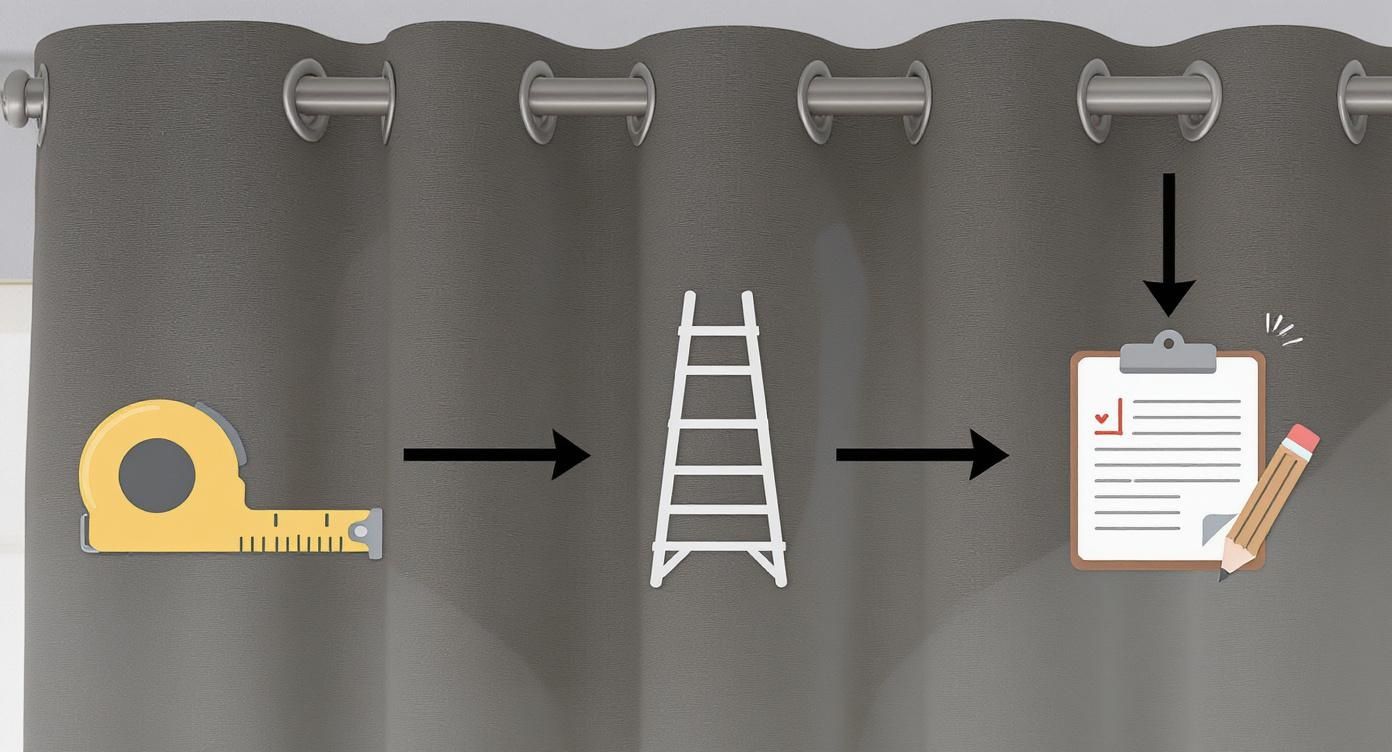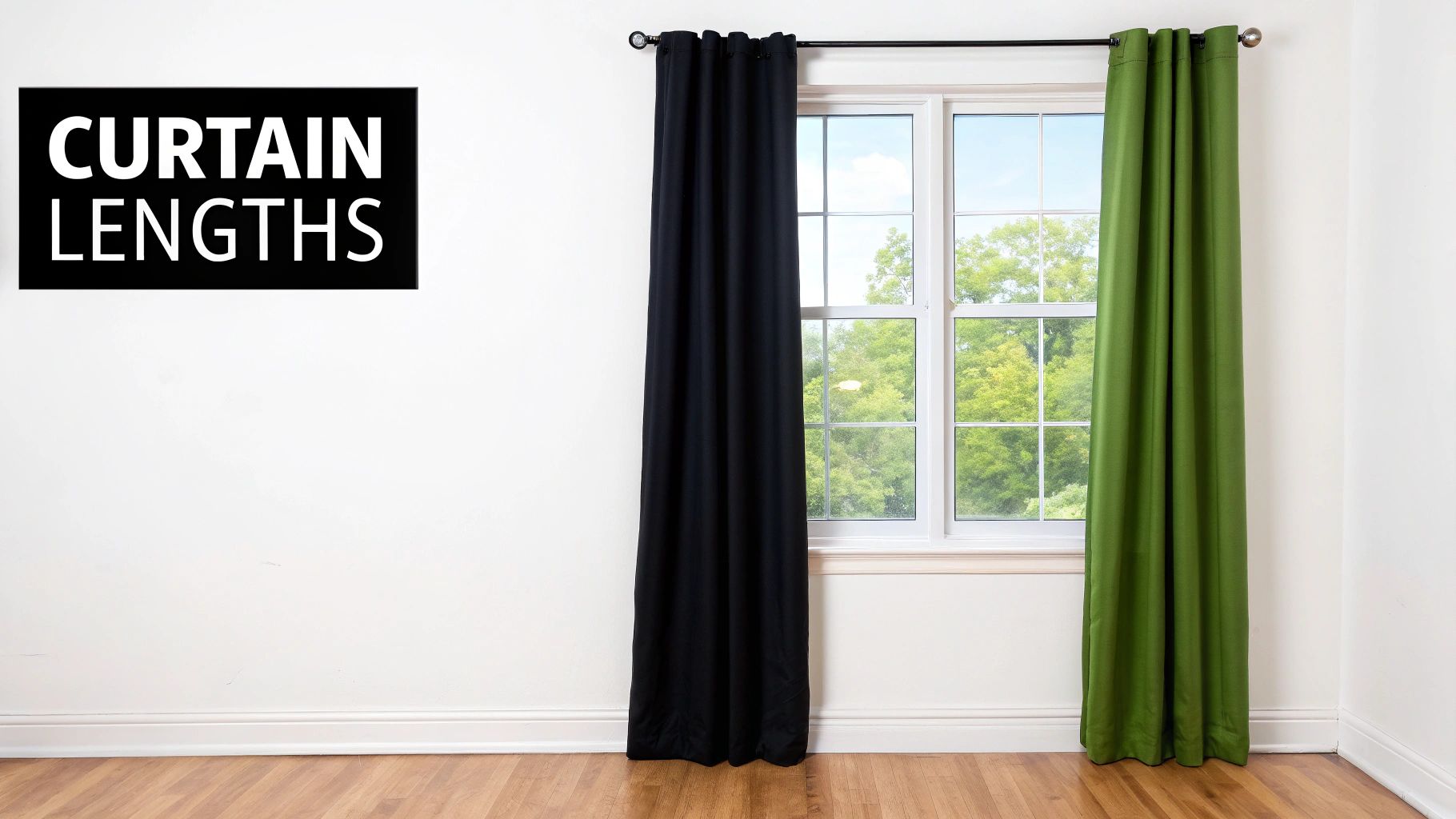
How to Measure Curtains Like a Pro for a Perfect Fit Every Time
Learning how to measure curtains is the secret to achieving that polished, designer look that can completely transform a room. It's about more than just covering the glass; the right measurements impact light control, privacy, and even energy efficiency. Think of this guide as your blueprint for window treatment success.
Table of Contents
- Why Accurate Curtain Measurements Matter
- Gathering Your Essential Tools
- How to Measure Curtain Width for Perfect Fullness
- Choosing The Perfect Curtain Length
- Adjusting for Curtain Styles and Hardware
- Frequently Asked Questions
Why Accurate Curtain Measurements Matter
Getting your curtain measurements right is the difference between a window that looks professionally dressed and one that feels like an afterthought. We're talking about a game of inches here, and those inches are what let you create powerful visual illusions that transform your space.
Want to make a small window feel grand and expansive? The short answer is to extend the curtain rod well beyond the window frame and hang the panels high. Similarly, floor-length curtains draw the eye upward, giving a room with low ceilings a surprising sense of height. These classic interior design tricks are impossible without nailing the initial measurements.
More Than Just Aesthetics
Beyond making your room look great, precise measurements directly affect how your curtains function day-to-day.
- Light Control: Panels that are too narrow will let annoying slivers of light sneak in around the edges. This completely defeats the purpose if you're aiming for a room-darkening or blackout effect.
- Privacy: With the right overlap and fullness, you won't have any gaps for prying eyes. It provides complete peace of mind.
- Energy Efficiency: Curtains that fully cover the window create an insulating pocket of air, reducing heat loss in winter and keeping your space cooler in summer. A study from the University of Salford found that drawing curtains at dusk can slash heat loss by a significant 15-17%.
This "measure-twice, buy-once" philosophy is critical for all kinds of home projects. For example, knowing how to measure a room for carpet accurately relies on the same core principle of precision for a flawless result.
Gathering Your Essential Tools
Before you start, let's get you set up for success. Taking a moment to gather the right tools is a small step that prevents frustrating errors and ensures you only have to do this once. Don't worry, you won't need anything fancy.
The most critical tool is a rigid, metal tape measure. Unlike soft fabric tapes that can stretch or sag, a metal one provides undeniable accuracy. A sturdy step ladder is also non-negotiable for safety and for getting a clear, eye-level reading for your rod placement. Finally, grab a simple pencil and notepad (or a notes app) to record your numbers immediately. This simple toolkit is what the pros use.
What You'll Need
- Metal Tape Measure: Its rigidity ensures your numbers are exact. A 25-foot tape is perfect for almost any window.
- Sturdy Step Ladder: This is for safely reaching the top of the window frame to get accurate height and rod placement measurements.
- Pencil and Notepad: So you can immediately jot down each dimension as you take it. No guessing later!
How to Measure Curtain Width for Perfect Fullness
Now, let's get into the details that give curtains that lush, high-end look. Measuring for width is about more than just the size of your window frame; it’s about creating scale and turning your windows into a true feature.
A common mistake is buying curtains that only just cover the glass. Instead, designers extend the curtain rod 6 to 12 inches past the window frame on each side. This simple trick lets the curtain panels pull completely clear of the glass when open, flooding your room with natural light.

The Secret to Luxurious Fullness
Ever wonder why some curtains look so rich and full? The secret is curtain fullness—the ratio of fabric width to the rod width. More fabric creates those deep, gorgeous folds. To calculate it, simply multiply your total rod width (including extensions) by a fullness factor.
- Standard Fullness (1.5x): This gives a clean, tailored look that works beautifully with patterned fabrics. (Rod Width x 1.5)
- Deluxe Fullness (2x): The industry standard for a classic, full appearance. It’s perfect for solid colors. (Rod Width x 2.0)
- Ultra Fullness (2.5x): For a truly opulent, dramatic effect with deep pleats. This looks incredible with sheers or velvet. (Rod Width x 2.5)
For example, if your window is 40 inches wide, you’d extend your rod to about 60 inches. For deluxe fullness (2x), you would need curtain panels that add up to a total of 120 inches in width (60 x 2).
Pro Tip: When calculating your fabric width, always round up. It's far better to have curtains that are a little too full than ones that look skimpy and can't close properly.
This math can feel a bit tricky, but don’t worry. To make it even easier, check out our guide on using a curtain width calculator to ensure your numbers are spot-on every time.
Choosing The Perfect Curtain Length
The length of your curtains can completely change a room's vibe, taking it from casual to formal in an instant. This is a key part of how to measure curtains correctly. Always measure from the top of your curtain rod down to where you want the fabric to end.

This final measurement defines the whole look. Let’s walk through the four main curtain lengths so you can pick the perfect style for your space.
Sill Length
Sill length curtains end right at the windowsill. This creates a neat, casual look that's incredibly practical for windows above furniture, kitchen counters, or radiators—anywhere longer curtains would get in the way.
Apron Length
For a more intentional look, apron length curtains extend about four to six inches below the windowsill. This style gives more visual weight than sill-length but avoids the formality of floor-length drapes. It's a versatile option for breakfast nooks or bathrooms.
Floor Length
Timeless and elegant, floor length is the most popular and professionally recommended style. These curtains just skim the floor or hover about a half-inch above it for a clean, tailored finish. This length is a designer's secret for making rooms feel bigger by drawing the eye upward.
For a deeper dive, explore our guide that answers the common question: do curtains need to touch the floor?
Puddle Length
For pure opulence, puddle length is the way to go. These curtains are intentionally long, extending onto the floor by an extra six to ten inches to create a luxurious "puddle" of fabric. This style is best for formal, low-traffic spaces like dining rooms.
Curtain Length Style Guide
| Length Style | Description | Best For | How to Measure |
|---|---|---|---|
| Sill | Curtains end exactly at the bottom of the windowsill. | Kitchens, bathrooms, kids' rooms, or over furniture/radiators. | Measure from the rod to the top of the sill. |
| Apron | Curtains extend 4-6 inches below the windowsill. | Casual living areas, breakfast nooks, and anywhere needing clearance. | Measure from the rod to 4-6 inches below the sill. |
| Floor | Curtains skim the floor or hang 0.5 inches above it. | Living rooms, dining rooms, and bedrooms for an elegant look. | Measure from the rod to the floor (subtract 0.5 inches for a hover). |
| Puddle | Curtains pool on the floor with an extra 6-10 inches of fabric. | Formal, low-traffic areas like dining rooms or master bedrooms. | Measure from the rod to the floor, then add 6-10 inches. |
Adjusting for Curtain Styles and Hardware
Your measurements aren’t final until you factor in your curtain style and hardware. These two elements can change your final numbers, so don't skip this step. The curtain's header style—the very top part—changes how it hangs from the rod, meaning the top edge of the fabric isn't always your true starting point.
Factoring In Different Curtain Headers
- Grommet Curtains: For curtains with metal rings (grommets), measure from the top inside edge of the grommet itself, not the top of the fabric. This is where the panel will rest on the rod.
- Rod-Pocket Curtains: For these classic panels, measure from the top of the pocket where the rod sits. Don't include any decorative fabric that sits above the pocket (often called a "header").
- Tab-Top or Tie-Top Curtains: Measure from the very top of the tab or tie down to where you want the curtain to end. This accounts for the entire visible length.
Expert Tip: That little bit of fabric above a grommet or rod pocket might seem insignificant, but it can easily add an inch or more to your length. Ignoring it is a common mistake that leads to curtains being too long.
How Hardware Affects Your Starting Point
Finally, your hardware sets the ultimate starting line for your vertical measurement. If you’re using a traditional rod, your measurement begins from the top of the rod. For more on placement, our guide on how high to hang curtains has fantastic expert tips. If you opt for a modern ceiling track, your starting measurement point will be the ceiling itself.
Frequently Asked Questions
We get it—measuring for new curtains can sometimes feel like a final exam. To help you get your numbers right with total confidence, here are quick answers to the questions we hear most often.
Should I measure the window or my old curtains?
How do I handle different sized windows in the same room?
How high above the window should I hang my curtain rod?
How far should a curtain rod extend past the window?
Feeling ready to find the perfect curtains? At Joey'z Shopping, we have a huge variety of styles to fit any window you’ve just measured. Explore our full collection of beautiful curtains today!
